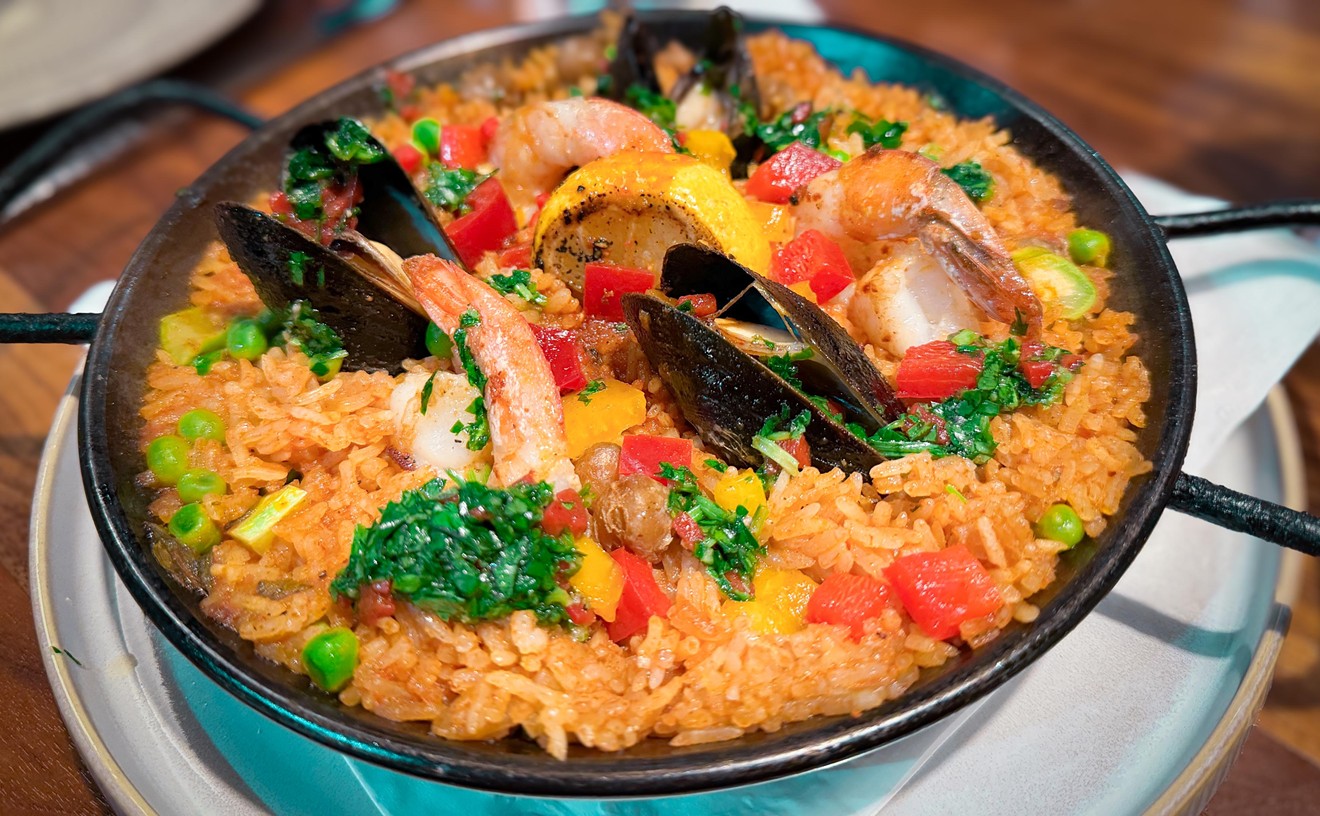OK, granted we weren't really paying attention as we flipped through the pages, what with the playoffs and all. But we noticed something interesting. The big guy once spent several paragraphs describing boiling water. Just about half of one short story discussed pancakes and some sort of luncheon meat. And in this particular story he pontificated at length about wineskins and the feel of a stream of fermented grape juice smacking against the back of your throat.
You'd expect someone given to that kind of detail would notice the tapas craze.
Of course, in those days, Americans called small servings dished out before dinner "bar food" or "appetizers." Italians refer to the stuff as antipasti. Indeed, every culture has a version of bite-sized meats, cheeses, whatever.
But Dallas restaurants don't hand out antojitos or meze menus. It's all about tapas. Old Republic serves "global tapas" and nothing more, which include such Spanish specialties as egg rolls, Asian dumplings and bruschetta. Stephan Pyles' new eponymous hotspot features a bar devoted to things like Ecuadorian potato cakes. More to the point, patrons picking through $2 nibbles at happy hour know a big ol' entrée follows at a "new American" restaurant. They order chips and salsa at a Tex-Mex joint, then retire to a table for the taco platter. When sitting down for an Italian meal, they rarely just settle for the antipasti. There's so much more to the cuisine. Pizza and such.
Why do we shortchange Spanish food?
"Even at Rouge I'm guilty of it," admits Joseph Gutierriz, chef at the Lover's Lane restaurant. "People understand tapas and paella, so we have to do what people expect."
Ah, but small plates, while hot items in Dallas restaurants (including the handful of Spanish places such as Hola, Café Madrid and Rouge), represent only a portion of the country's cuisine. Indeed, tapas are generally considered early evening snacks. The word means "top" or "cover," a remnant of the days when bartenders would place bread or a saucer on glasses to keep out the flies.
Appetizing, huh? Eventually stopping for tapas became customary, a precursor to dinner.
Centuries ago, mariners from the Iberian peninsula returned from the new world with chilies, tomatoes, bell peppers and other oddities. Before that, invaders from around the Mediterranean introduced a range of sweet and savory dishes. The mountains and the coastal areas show other influences. Every part of the country, perhaps every family, tweaks paella to their own tastes. "The culture of Spain is so vast, so unique," Gutierriz explains, "cross the street and you find different food." In more general terms, should the Burning Question crew raise enough money selling odds and ends we snatch from our editor's office on eBay to pay for another trip to Europe...But that's an aside. Should we stagger down the roads of Spain from north to south we'd encounter people devoted to a red meat and potatoes diet, then find ourselves dining on things like mutton and chickpeas. Finally we'd hit the pork and rice region. Chef Gutierriz grew up in Andalusia, but his mother is Basque, a people favoring such refinements as squid cooked in its own ink.
People in many regions enjoy game--pigeon, boar, partridge and rabbit. A few months ago Joel Harloff, chef at Landmark Restaurant in the Melrose Hotel, hosted a Spanish dinner of almejas con alcachofas (clams with artichokes) and conejo en salsa de almendras, or rabbit in almond sauce. The cute, furry critters are not commonly seen in Dallas kitchens, and as he cleaned the meat Harloff noticed his line cooks looking on with great curiosity. Finally one of the staff spoke up: "Chef...gato?"
Note to self: Don't order rabbit in a Mexican restaurant.
"Rabbit is popular in Spain," Gutierriz points out. "My mom goes to the market every day, and if she gets rabbit, they skin it right there." KDFW-Channel 4 weather babe Maria Sotolongo, a former Spaniard (her brother owns a tapas place, Rioja, in Houston) misses the broad-minded approach to food. "In Spain you eat anything," she explains. "I'm not particularly fond of cow parts, but I like rabbit." Sophisticated residents here scorn beef entrails and cooked rodent, however. "It's hard to get people in Dallas to eat wild game," Harloff says. "It seems they'd rather just shoot it."
So there you have it. There's more to Spanish cuisine than bar food. Lamb, for example, and empanadas, scallops, cured ham, salted cod and roasted oxtail. Dishes waver between the simplicity of fresh ingredients and a complex balance of diverse flavors--chilis and citrus and chocolate and such. To chef Daniele Puleo of the Italian spot Daniele Osteria it's similar to cuisine native to his peninsula. Come mealtime, he says, people in both countries prefer to "buy the best and leave it alone."
Still, if you'd rather stick to tapas, at least try something traditional. Tortilla de papas (potato omelet), now that's a classic tapa.
Of course, so is eel fried with red pepper.










